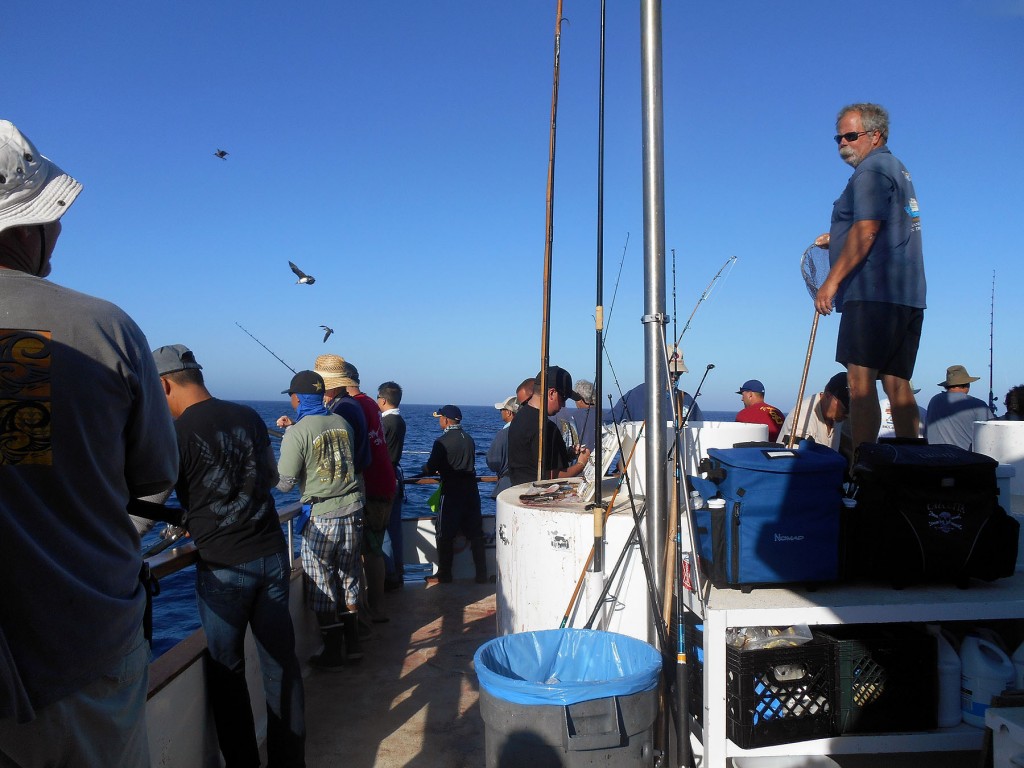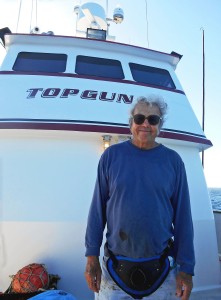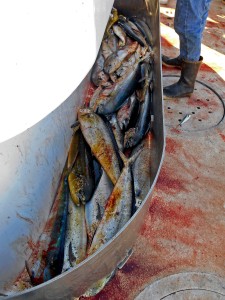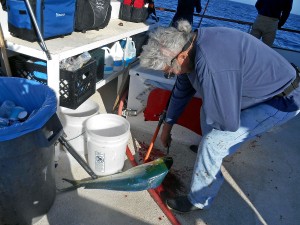It’s been a couple of years since we’ve gone offshore to fish for tuna, but this fall the fabulous reports of daily limit catches from Mexican waters all the way up to the Channel Islands caught our attention. On top of that, Pam has pulled in a lot of salmon but she’s never caught a tuna so we said, “Why not?” I’ve always had good luck fishing out of H & M Landing in San Diego so we opted for a day and half trip on the Top Gun 80, one of the landing’s larger boats, with a limited load of 25 anglers and comfortable bunk space spread out in 2- and 3-person cabins. With that decision made, it set off a chain of events that followed.
Sometimes planning for a trip is almost as much fun as taking the trip itself, and this outing was no exception. First, we had to dig out gear we hadn’t used for a while and select four rods, two for each of us. Naturally we replaced all of the line on the reels. You know it’s always better to be safe than sorry so we spooled up with new 20 lb.- and 30 lb.-test mono in preparation. A lot of people bring heavier outfits, but according to everything I’d read, the fish were not running that large so we figured we’d be good to go with the lighter gear. To be on the safe side, I also made up appropriate leaders from fluorocarbon material attached to swivels in case the fish were spooky. Although I have an assortment of feathers and jigs, we opted to be bait fishermen on this trip so the only other tackle we needed were a few twist-on sinkers and a box of hooks ranging from size 2/0 down. That eliminated the need for a big tackle box making things relatively simple to carry onto the boat. As it turned out, we were over prepared. The fish that day hit anything and everything, so my leaders went unused. Still, as the Boy Scouts say, it’s better to be prepared. Step one completed, we were ready to go.
A day and a half boat translates to one full day of fishing. You drive to the dock and board in the early evening. Our boat left at 8:00pm, picked up bait, and then sailed past the Coronado Islands into Mexican waters. Yes, if you fish in Mexico, a Mexican fishing permit is required and you have to carry photo ID. A fishing license is required if you fish in US waters, too. No drugs or alcohol are allowed on the boat, but they do sell beer. You will be bouncing around a little in your bunk while traveling so take along some seasick pills if you need them. Bunks come with a pillow and a blanket but no towel so bring one. The boat has a big galley so food and beverages are also available. Our trip price included food, which was nice, and I have to say it was excellent fare and there was a lot of it. No one went hungry, and I doubt if anyone lost any weight either, so don’t bother packing lunch or snacks. The Top Gun 80 gets five stars for food and for its overall comfort when compared to other boats I’ve been on. The crew worked hard to get us fish, too. We were very pleased with this boat and will definitely go on it again.
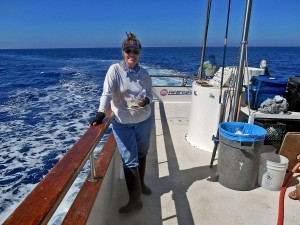 Since Pam had never fished on an open party boat, I spent some time talking to her about the chaos that ensues when everyone hooks up at the same time and bent rods pull anglers in several different directions along the rail. I don’t think she believed me then, but later we had a good laugh about those situations. “A stop on a school of fish can be for a limited time only so you have to keep bait in the water when they’re biting.” I told her. “Be polite but firm when moving past other fisher people, and follow your fish around the boat keeping your line in front of you. You will likely get in a tangle so don’t be afraid of cutting your line and tying on a new hook. Oh! And yes, you will have to bait your own hook with live bait and unhook your own fish too. You may even have to drag your own fish down the deck and sack it up so you will get fish blood on your clothes. That means don’t dress for fashion. No breaks while they’re biting either, even if you get tired.” Pam laughed at that one, but hung in with the rest of us during the bite. “The crew is out there every day so they know what they’re doing. Let them help you if they offer,” I said, but Pam preferred to do it on her own saying it was more fun. That was all good advice I gave, but talk’s cheap until you experience the real thing. And guess what, all of it came true.
Since Pam had never fished on an open party boat, I spent some time talking to her about the chaos that ensues when everyone hooks up at the same time and bent rods pull anglers in several different directions along the rail. I don’t think she believed me then, but later we had a good laugh about those situations. “A stop on a school of fish can be for a limited time only so you have to keep bait in the water when they’re biting.” I told her. “Be polite but firm when moving past other fisher people, and follow your fish around the boat keeping your line in front of you. You will likely get in a tangle so don’t be afraid of cutting your line and tying on a new hook. Oh! And yes, you will have to bait your own hook with live bait and unhook your own fish too. You may even have to drag your own fish down the deck and sack it up so you will get fish blood on your clothes. That means don’t dress for fashion. No breaks while they’re biting either, even if you get tired.” Pam laughed at that one, but hung in with the rest of us during the bite. “The crew is out there every day so they know what they’re doing. Let them help you if they offer,” I said, but Pam preferred to do it on her own saying it was more fun. That was all good advice I gave, but talk’s cheap until you experience the real thing. And guess what, all of it came true.
We got our first stop at daybreak and in less than an hour everyone had caught limits of yellowfin tuna, and the crew already had them chilling in the fish hold. There were also some skipjack that we mostly threw back. The deck was a bloody mess, as were both my wife and I. Arms and backs were tired, fishing poles needed new hooks, and breakfast was getting cold. But there were a ton of smiles all around. And we still had ten more hours to fish. The rest of the day was spent looking for kelp paddies and scratching out Dorado averaging a fish and a half per rod. We had time to eat a good lunch and to enjoy afternoon cheese and crackers. We also had time to drink sodas or a few beers, and to gaze at the ocean and watch dolphin and flying fish. There were a lot of fish stories told and new friends made. What a great day at sea!
At dusk the fishing stopped, and after dinner everyone quickly hit their bunks and called it a day, sleeping through the night and waking up back at the dock early the next morning. Nothing left to do then but unload gear, and to pick up sacks of fillets and throw them on ice in the cooler you brought in your car. After paying our fish cleaning bill and tipping the crew,we stopped for breakfast in town to let the morning traffic die down. Then we spent a leisure drive home and an afternoon processing fish fillets for the freezer. I wasn’t surprised when Pam told me she’d like to do it again, and so would I. And if we didn’t already have a freezer full of fish we’d be back there this week. This time the fishing reports were all true, so If you have the inclination, as the saying goes, we recommend that you just do it. We will go again when the freezer is empty, but unfortunately for us, that’s probably not going to be until next year.

